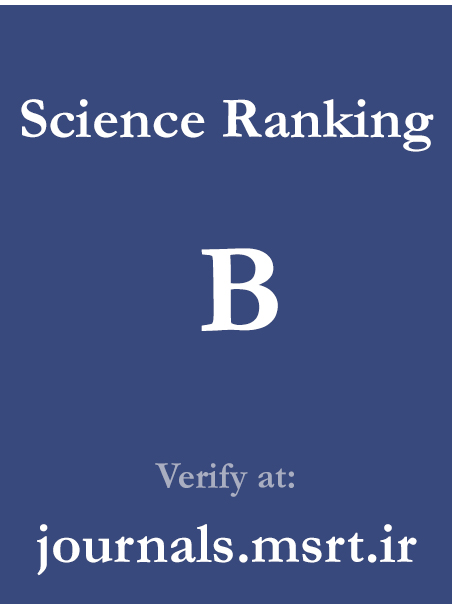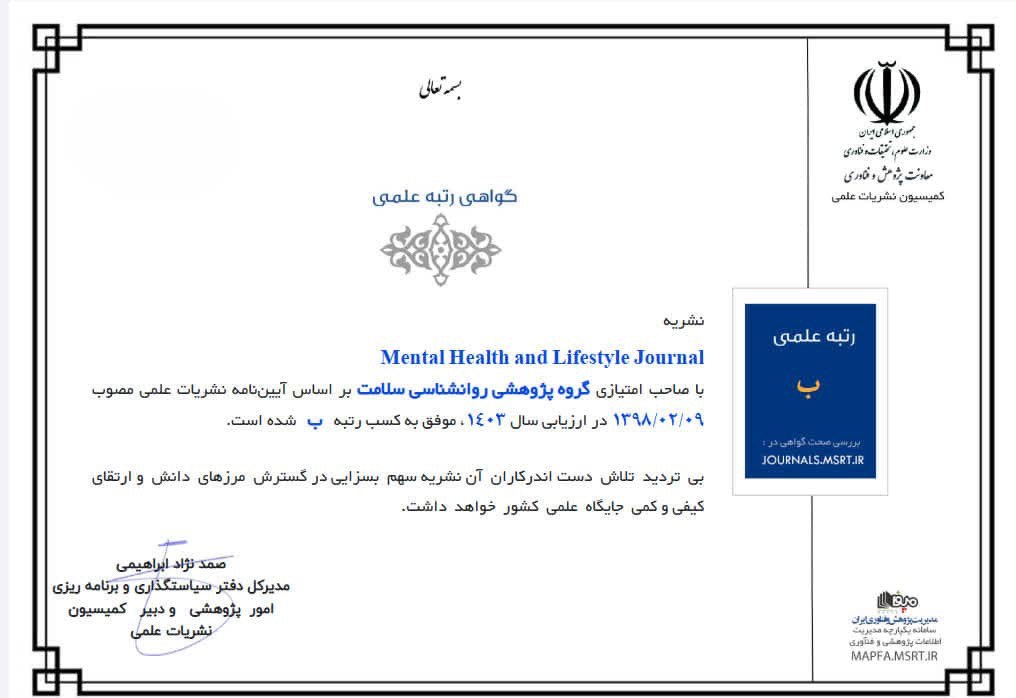The Mediating Role of Fear of Missing Out (FOMO) and Loneliness in the Relationship Between Internet Addiction and Rumination in Adolescents
Keywords:
Internet addiction, Rumination, Fear of Missing Out (FOMO), Loneliness, AdolescentsAbstract
This study aimed to investigate the mediating roles of fear of missing out (FOMO) and loneliness in the relationship between internet addiction and rumination among adolescents. A descriptive correlational design was employed with a sample of 388 adolescents from Tehran, selected based on Morgan and Krejcie’s sampling table. Participants completed standard self-report instruments measuring internet addiction, FOMO, loneliness, and rumination. Descriptive statistics and Pearson correlation coefficients were analyzed using SPSS-27, while structural equation modeling (SEM) was conducted using AMOS-21 to test the mediating roles of FOMO and loneliness in the proposed model. The model fit was assessed using indices including Chi-square, RMSEA, CFI, TLI, GFI, and AGFI. Internet addiction was positively and significantly correlated with FOMO (r = .59, p < .001), loneliness (r = .41, p < .001), and rumination (r = .52, p < .001). SEM results confirmed the direct effect of internet addiction on rumination (β = 0.23, p < .001) as well as significant indirect effects through FOMO (β = 0.28, p < .001) and loneliness (β = 0.20, p < .001). The total effect of internet addiction on rumination was substantial (β = 0.71, p < .001). The structural model demonstrated good fit indices (χ²/df = 2.06, CFI = 0.96, RMSEA = 0.053, GFI = 0.94, TLI = 0.95). The findings suggest that both FOMO and loneliness serve as significant mediators in the relationship between internet addiction and rumination in adolescents. These results highlight the need for targeted interventions addressing emotional vulnerabilities and digital behaviors to mitigate cognitive risks associated with excessive internet use.
Downloads
References
1. Zhu X, Lian W, Fan L. Network Analysis of Internet Addiction, Online Social Anxiety, Fear of Missing Out, and Interpersonal Sensitivity Among Chinese University Students. Depression and Anxiety. 2024;2024:1-14. doi: 10.1155/2024/5447802.
2. Fuadiyah J, Valentino RA, Samosir FT. Dampak Sindrom Fear of Missing Out (FoMO) Terhadap Pola Pencarian Informasi Mahasiswa Dalam Prespektif Krikelas. Jipi (Jurnal Ilmu Perpustakaan Dan Informasi). 2023;8(2):385. doi: 10.30829/jipi.v8i2.16411.
3. Jin Y, Xiong W, Liu X, An J. Trait Mindfulness and Problematic Smartphone Use in Chinese Early Adolescent: The Multiple Mediating Roles of Negative Affectivity and Fear of Missing Out. Behavioral Sciences. 2023;13(3):222. doi: 10.3390/bs13030222.
4. Wang Y, Liu B, Zhang L, Zhang P. Anxiety, Depression, and Stress Are Associated With Internet Gaming Disorder During COVID-19: Fear of Missing Out as a Mediator. Frontiers in Psychiatry. 2022;13. doi: 10.3389/fpsyt.2022.827519.
5. Aldbyani A. Mindfulness Associated With Less Fear of Missing Out: Social Media Addiction as a Mediator. 2024. doi: 10.21203/rs.3.rs-3872015/v1.
6. Sainy DM. A Study on Impact of Smartphone Usage and Fear of Missing Out [FOMO] Among Older Adults of Raipur. International Scientific Journal of Engineering and Management. 2025;04(06):1-9. doi: 10.55041/isjem03937.
7. Beige EPM, Matulessy A, Suhadianto S. Kecanduan Internet Dengan Fear of Missing Out : Apakah Memiliki Keterikatan? Jiwa. 2023;1(2). doi: 10.30996/jiwa.v1i2.9940.
8. Setyaningsih NR, Sarjana W, Wardani ND. The Correlation Between Fear of Missing Out (FoMO) and Internet Addiction in Vocational High School Students. Jurnal Psikiatri Surabaya. 2023;12(1):44-55. doi: 10.20473/jps.v12i1.30653.
9. Zhang Y, Shang S, Tian L, Zhu LJ, Zhang W. The Association Between Fear of Missing Out and Mobile Phone Addiction: A Meta-Analysis. BMC Psychology. 2023;11(1). doi: 10.1186/s40359-023-01376-z.
10. ÇİFÇİ S, Kumcağız H. The Relation Between Fear of Missing Out and Subjective Well-Being: The Mediating Role of Social Comparison and Loneliness. E-International Journal of Educational Research. 2023. doi: 10.19160/e-ijer.1187412.
11. Kholisah N, Suhesty A. Fear of Missing Out Dan Narsisme. Ganaya Jurnal Ilmu Sosial Dan Humaniora. 2025;8(2):139-52. doi: 10.37329/ganaya.v8i2.4068.
12. Murari K, Shukla S, Dulal L. Social Media Use and Social Well-Being: A Systematic Review and Future Research Agenda. Online Information Review. 2024;48(5):959-82. doi: 10.1108/oir-11-2022-0608.
13. Türk F, Koçyiğit B. The Relationship Between Fear of Missing Out and Loneliness Among Adolescents in the Digital Age: The Mediating Roles of Emotion Dysregulation and Social Media Addiction. Malaysian Online Journal of Educational Technology. 2025;13(1):19-36. doi: 10.52380/mojet.2025.13.1.566.
14. Arizka R, Khotimah H, Supraba D. How Big Is the Role of Loneliness on Fear of Missing Out? : A Study on Teenage K-Pop Fans. Journal of Health and Behavioral Sciences. 2024;6(2):160-71. doi: 10.35508/jhbs.v6i2.17389.
15. Šramová B, Hamranová A. Psychological and Social Risks of Digitalization in Adolescents. 2022. doi: 10.36315/2022v1end059.
16. Varchetta M, Tagliaferri G, Mari E, Quaglieri A, Cricenti C, Vilar MM. Cross-Cultural Examination of Problematic Internet Use and Associated Psychological Variables: A Comparative Study in Italy, Spain, Ecuador, and Peru. Journal of Clinical Medicine. 2024;13(12):3451. doi: 10.3390/jcm13123451.
17. Manap A, Rizzo A, Yıldırmaz A, DİLekÇİ Ü, Yıldırım M. The Mediating Role of Procrastination in the Relationship Between Fear of Missing Out and Internet Addiction in University Students. International Journal of Environmental Research and Public Health. 2023;21(1):49. doi: 10.3390/ijerph21010049.
18. Ardyan E, Sanapang GM. Online Compulsive Buying and Brand Addiction in Indonesia: The Importance of Using Fear of Missing Out and Social Commerce Interactivity. The Winners. 2023;24(2):117-26. doi: 10.21512/tw.v24i2.10817.
19. Adiningsih DS. Kecanduan Internet Pada Remaja: Peran Extraversion Dan Fear of Missing Out. Paedagogy Jurnal Ilmu Pendidikan Dan Psikologi. 2025;5(1):125-35. doi: 10.51878/paedagogy.v5i1.4762.
20. Rahmadania A, Sanyata S. Fear of Missing Out on Workplace: A Systematic Literature Review. International Journal of Multicultural and Multireligious Understanding. 2023;10(11):73. doi: 10.18415/ijmmu.v10i11.5115.
21. Harorlı H, Harorlı OT. Fear of Missing Out and Internet Addiction: A Survey of Dental Students. Journal of Dental Education. 2024. doi: 10.1002/jdd.13809.
22. Szawłoga T, Soroka K, Śliwińska M. Relationship Between Fear of Missing-Out and Adolescents Mental Health. Environmental Medicine. 2024;27(1):18-22. doi: 10.26444/ms/187716.
Downloads
Published
Submitted
Revised
Accepted
Issue
Section
License

This work is licensed under a Creative Commons Attribution-NonCommercial 4.0 International License.








